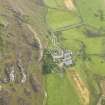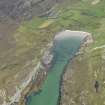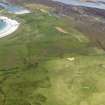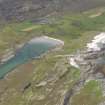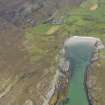Oronsay, 'priory Midden'
Shell Midden (Mesolithic)
Site Name Oronsay, 'priory Midden'
Classification Shell Midden (Mesolithic)
Canmore ID 37823
Site Number NR38NW 2
NGR NR 3468 8895
Datum OSGB36 - NGR
Permalink http://canmore.org.uk/site/37823
- Council Argyll And Bute
- Parish Colonsay And Oronsay
- Former Region Strathclyde
- Former District Argyll And Bute
- Former County Argyll
NR38NW 2 3468 8895.
NR 347 889. Shell-midden located 200m west of Oronsay Priory (NR38NW 1) (Possibly Medieval - see NR38NE 12).
W G Jardine 1971
NR 3468 8895 An oval mound, measuring 20.0m NW-SE by 18.0m and up to 1.6m high, with shell exposed in the SW. It is similar in appearance to other shell-middens that have been excavated in the area.
Visited by OS (BS) 3 April 1974.
Desk Based Assessment (2 August 1972)
NR 347 889. Shell-midden located 200m west of Oronsay Priory (NR38NW 1) (Possibly Medieval - see NR38NE 12).
Information from OS (ES) 2 August 1972
Source: W G Jardine 1971
Field Visit (3 April 1974)
NR 3468 8895. An oval mound, measuring 20.0m NW-SE by 18.0m and up to 1.6m high, with shell exposed in the SW. It is similar in appearance to other shell-middens that have been excavated in the area.
Visited by OS (BS) 3 April 1974.
Note (January 2017)
Mesolithic Scotland
The next stage of our journey through time takes us to a small island off the west coast of Scotland. The island of Oronsay sits directly to the south of its bigger brother Colonsay. Both are part of the island group known as the Inner Hebrides. Although Oronsay is relatively small, only 5km2 in size, it is rich in archaeology. In fact, Oronsay is home to the highest identified concentration of Mesolithic sites in Scotland dating to sometime between 7000 and 5000 years ago.
The Stone Age is split into three recognised phases: the ‘Palaeolithic’ meaning the old stone age, the ‘Mesolithic’ meaning the middle stone age and the ‘Neolithic’ meaning the new stone age. Much like the Palaeolithic age, there are very few known archaeological sites in Scotland that have been dated to the Mesolithic. Those that have been identified suggest that the communities moved around and survived by gathering food and hunting, likely using water as the primary method of transport.
One of the main site types that have been identified are known as ‘middens’. These are large mounds made of huge quantities of sea shells and other waste material. There are at least five known middens on Oronsay which include shells such as limpets, periwinkles, whelks, oysters, cockles, scallops and razorshells as well as a variety of fish. They have been found to contain very few remains from mammals that live on land or from birds.
Food and function
The primary type of fish identified in the Oronsay middens is from a species known as Saithe – a type of Pollock. This fish grows rapidly during the first 2-3 years of life. By examining the size of Saithe earbones recovered from the middens, archaeologists have been able to establish during which season the fish were caught at each site. Interestingly, the five middens examined across the island appear to have been occupied at different times of year. Archaeologists think that either there was one population of people living on the island who moved from place to place throughout the year, or that foragers from the mainland travelled across to Oronsay and camped at specific places in different seasons.
Middens are thought to have mainly functioned as rubbish dumps, created over numerous generations through fishing or shell-gathering expeditions. However, some archaeologists have suggested that middens have other, or even multiple, purposes. Could they have been created as boundary markers between different territories? Or perhaps, as occasional human toe or finger bones have appeared at midden sites, could these be places where bodies were prepared for burial or where mortuary rituals were practiced that we do not understand today?
Maya Hoole - Archaeology InSites project manager















